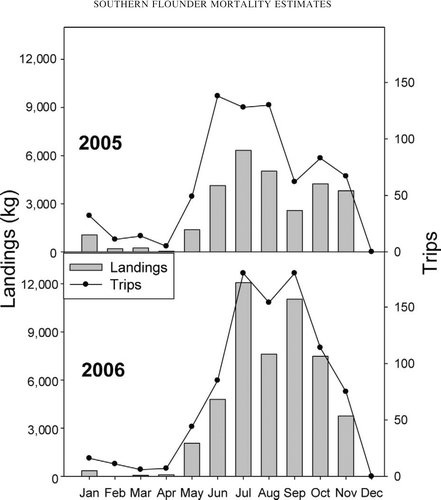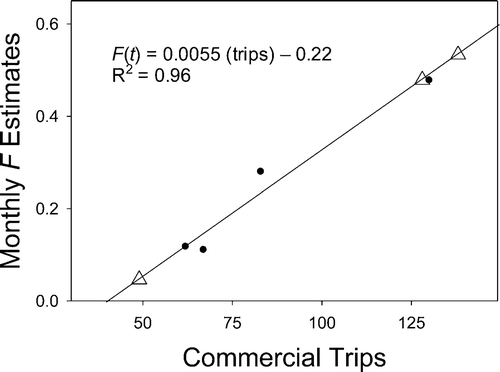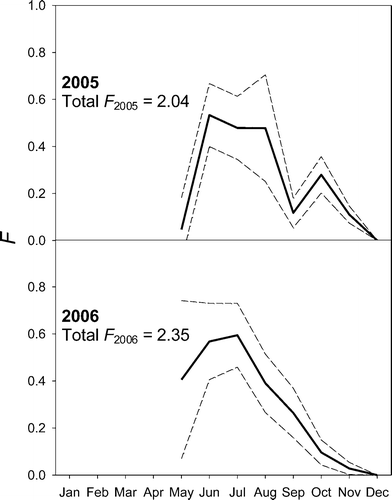Figures & data
Table 1. Expected tag recovery matrix using a discrete-rates formulation (CitationBrownie et al. 1985) and assuming no violation of assumptions (j = month of recovery; N = number tagged during each time interval; f = return rate; S = survival). For the instantaneous rates formulation and the integrated tag retention model, parameters s, λ, ρ, and Φ are added to account for short-term survival of tagging, tag reporting, immediate tag retention, and long-term tag shedding
Figure 1. New River, North Carolina, commercial landings of southern flounder and trips in the years 2005 and 2006. Note that in both years, lower landings and fewer trips were documented in January to April compared with all other months during the fishing season.

Table 2. Observed recoveries matrix of all southern flounder tagged with standard tags, high-reward tags, and double tags in the New River, North Carolina, and recovered during 2005 and 2006. Only asterisked data were used in the tagging models. For tag retention method 1, all double-tagged fish were added to the standard tag matrix, with the exception of three recoveries (1 fish each from the August 2005 cohort in September and October 2005 and 1 fish from the May 2006 cohort in July 2006). For tag retention method 2, no double-tagged fish were added to the standard tag matrix
Table 3. Times at large and totals for all double-tagged southern flounder that were recovered in the New River, North Carolina, commercial gill-net fishery (TT = double-tagged fish that were recovered with both tags intact; T = double-tagged fish that were recovered with only one tag intact)
Table 4. All estimated southern flounder model parameters generated by using three different tag retention and tag return models and averaging over the five candidate models listed in (ρ = short-term tag retention probability; φ = instantaneous rate of tag loss; λ = tag reporting rate; M = instantaneous rate of natural mortality; CI = confidence interval, given in parentheses). Estimates of instantaneous fishing mortality (F) are based on tag return models for August to November 2005 and May to November 2006 and regression analysis for May to July 2005. Parameter φ in the joint-likelihood models was converted to a monthly rate for comparisons with φ in the integrated model
Table 5. Southern flounder tagging model results based on joint-likelihood method 1, listed from lowest to highest value of the quasilikelihood Akaike's information criterion (QAIC; M = instantaneous rate of natural mortality; wr = model weight; F = instantaneous rate of fishing mortality; CI = confidence interval; FMP rate = M given in the southern flounder fishery management plan [CitationNCDMF 2004]). Values of F include only tagging model estimates (August to November 2005 and May to November 2006)
Figure 2. Linear relationship between New River, North Carolina, commercial trips and monthly estimates of the southern flounder instantaneous fishing mortality rate (F) generated by the tagging model using joint-likelihood method 1 (see Methods) for August to November 2005. The line is the estimate of the fitted regression model. Black circles denote tagging model F-estimates versus trips; open triangles illustrate the predictions of F for May to July 2005.

Figure 3. Monthly estimates of the southern flounder instantaneous fishing mortality rate (F; solid lines) and 95% confidence intervals (dashed lines) for 2005 and 2006 generated by using joint-likelihood method 1 (see Methods). The F 2005 was estimated using both the tagging and regression models, and F 2006 was estimated using the tagging model.
